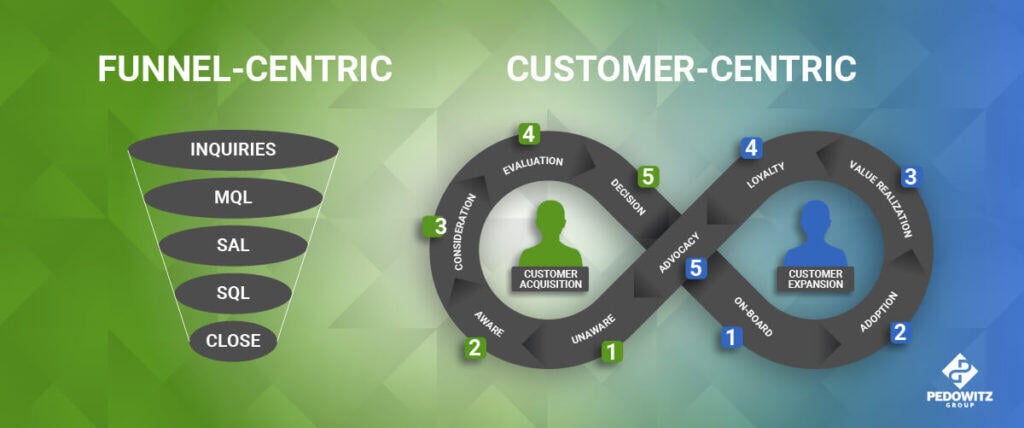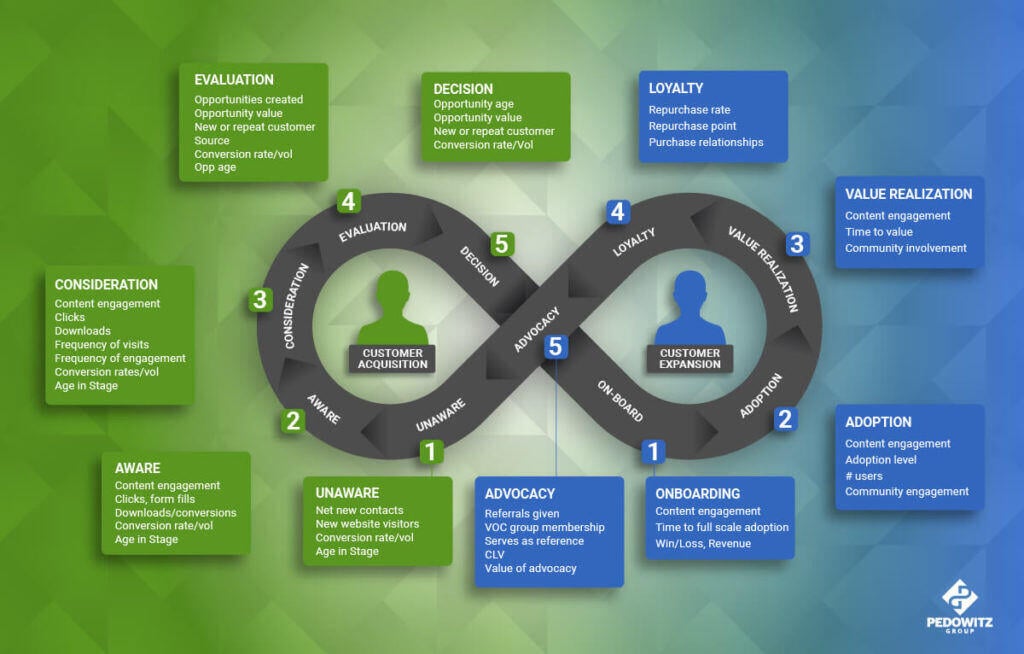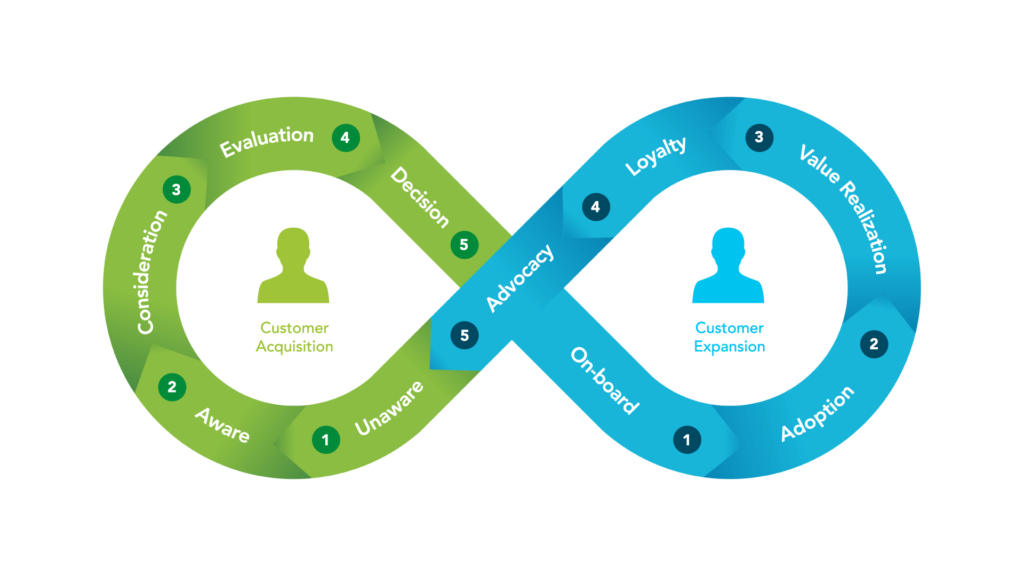With marketing, there are few more important things to know in the pursuit of becoming a truly customer-centric company than the customer journey.
But far too often, businesses ranging from the Fortune 100 to medium-sized businesses don't have this built out. Either they haven't updated it in years or never finished building it.
Let's change that! Here is a fantastic starting point for building or updating your customer journey for your marketing.
Click to jump to a section: Who owns the journey? | Map it out | Now, quantify it | A better concept: The Loop
Why is this important?
- Customer-centric companies are 60% more profitable than companies that don't focus on customers. (SuperOffice)
- Companies that use tools like customer journey maps reduce their cost of service by 15-20%. (McKinsey)
- When B2B buyers consider a purchase‚ they spend only 17% of that time meeting with potential suppliers. (Gartner)
- 84% of customers feel that experiences are as meaningful as the actual products and services. (Salesforce)
- Campaigns generating top-of-funnel inquiries increased by 721% when actively using personas. (Marketing Sherpa)
Ask yourself, what would even a 1% improvement in any of these stats do for your company?
We have 100+ more related statistics if you want more.
There is significant bottom-line potential related to the customer journey and getting it right, and you will only truly embrace a revenue marketing mindset with this.
Who owns the customer journey?
This is one of the most important questions to ask, and there are several dimensions to this question.
- First, you need to ask this question needs. In many companies, it hasn't!
- Second, create a definitive answer needs. The customer is in control of their relationship with you ... and if you don't or won't work to engage and create an optimal customer experience, your client will find a vendor who will.
- Finally, manage the customer journey as a whole, not a series of disconnected pieces.
It varies across companies
CMOs today are faced with increasing responsibility for their customers’ experience. And it's one of the top challenges they cite in Gartner's CMO Survey.
However, other strategic capabilities gaps still persist: Marketing data and analytics was identified by 26% of CMOs as a top capability gap, followed by customer understanding and experience management (23%), and marketing technology (22%).
These specific instances illustrate a larger resource challenge for CMOs, with the majority (61%) of CMOs reporting that their teams lack the capabilities required to deliver their strategy."
More and more organizations are realizing the benefits of paying attention to their customers’ buying journeys. Does all this extra work pay off?
Yes! And just one dataset in this RevOps report shows how alignment between sales, marketing, and customer success drives better employee and customer experiences.
So, who should own it?
There should be input from any customer-facing department, ranging from marketing to sales, product management to customer service, and more. No matter your industry.
Ultimately, revenue is a team sport.
Key stakeholders exist everywhere - and their input is valuable! There must be a leader, of course. In that case, there are bound to be fractures that ultimately cost you revenue, resulting in disjointed customer experiences or go-to-market strategies that don't cooperate.
Often, I've seen companies house the customer journey in their marketing Center of Excellence, a central team that impacts many related parts of the organization. At the very least, you must have a Customer Engagement Council comprised of key stakeholders who understand the customer and invest in a customer-first mindset.
This Council (or section of your Center of Excellence) provides multiple benefits:
- Provides a natural point for numerous inputs from across the organization
- Fosters an environment to build the one customer journey you will use across all teams
- Gives company leadership a clear hierarchy + makes it easier to gain buy-in when needed
- Makes it easier to include actual customer feedback from a variety of needed sources
At a bare minimum, you will need input from sales, marketing, customer service, product, and IT. Consider including finance and engineering for unique input that ultimately gets back to the customer. There may be other departments that make sense to include, as well.
The Customer Engagement Council will provide input, gather feedback, keep the journey on track, and maintain timing. The input they provide will involve sharing expertise from their own client interactions in order to help build the initial customer journey.
They can share expertise from their functional area to map how the company relates to the customer journey.
They will gather feedback from customers, working with customers to validate the journey as the journey is being mapped out (or revised). Typical timelines for this are 3-4 months, so make sure to set expectations accordingly.

Map Your Customer Journey
Mapping involves detailed planning and engagement from all levels of your organization. You must create and deliver a pitch to executives to earn their support, establish a cross-functional team (or center of excellence) to keep this momentum going, and plan the steps to mapping the customer journey.
If you don't have a Customer Engagement Council, you'll need to start there. Without the requisite structure in place to create, maintain, and enforce the journey map, there's no point in even having it ... each team will do whatever it wants.
With that in mind, here are the steps:
Understand everyone's relation to the customer
Mapping the journey begins by charting which departments interface with customers, and which support those interactions. For example, customer service is the former, but finance or IT is likely the latter.
Think through these six different areas to really make sure you lock in the departments into the right area:
- Stakeholder R&R
- Processes
- Technology
- Data
- Communication
- Collaboration
- Continuous improvement
More on this in a moment.
Build A Draft
Start with a baseline. Your Council has enough organizational knowledge to create a full map, from initial outreach to building the post-sale relationship. However, you need a particular model to build around ... or update your outdated model.
There are a few good models in the market today, but I'll put the TPG's Loop customer journey model against any of them. This infinity loop methodology forces companies to think through two primary cycles: Customer acquisition, and customer expansion with existing customers.

Many models handle acquisition well, but often don't link it to retention / expansion. It's far more cost-effective to get more business from current customers who trust you!
Now that you have an ideal model, go stage-by-stage through it and establish your initial baseline by:
- Identifying the key question(s) a person is trying to answer
- Highlighting what content you have that can address these questions (this will be key for go-to-market strategies later)
Your customer-facing departments may have more to say on the customer acquisition part of the Loop, but all departments should have valuable insight into the customer expansion mapping!
Each part has a link in the description to the slides so you can work through this exercise as we go along!
Validate
It's time to test your draft and bulk it up. Leverage substantial focus groups and / or interviews with customers, surveys, and any available data you have internally to help revise your initial draft.
Some great examples of data:
- Customer service logs
- Sales activity reports
- Marketing campaign data
There are many more, and don't allow this data to substitute for true voice of the customer activities that should inform how to revise your customer journey map.
Improve
Now that you have a customer journey your entire company rallies around, it’s time to keep it updated.
Every six months, regroup your council to validate and update your mapping. In this fast-paced, high-tech world, customers are always finding new ways to research your products / services and learn what's available to them on the market.
The burden is on you to keep up, so make sure to have time marked on everyone's calendar to do just that!
Quantify Its Impact
So, you have a cross-functional council / team that has a customer journey you're using across the organization. How can you prove your efforts are having bottom-line impact, in true revenue marketing fashion?
One major caveat
Do not try to measure everything!
This is where even great marketers can destroy everything. If you try to report on too much, or the wrong data, then you'll undermine the entire purpose of the customer journey.
For each stage, try to pick one metric that you would use as a key performance indicator. You may have to use two to get a full picture (that's okay, but each step shouldn't have two) ... but keep in mind what you would / wouldn't report to an executive.
Simplicity will be key here.
A New Scorecard
The new scorecard includes metrics from all stages of the customer journey. Below is an example of possible tactics. With a model that takes into account the entire customer journey:
- There is more to measure
- There are new things to measure
- Working with other functions on measures
- How all the measures work together
On the left in the infinity loop, you'll use many typical funnel stages such as leads generated, pipeline produced, etc. You may also overlay buying stage data if you have that available + re-examine all facets of your lead management process.
On the right, you'll focus on processes after the sale. These feed into a customer's likelihood of buying from you again, so putting equal effort into measuring these is important!

You'll also want to dedicate time within your Council to:
- Examine procedures for buying technology
- Focus on data governance and accountability for clean data
The Mind Shift
Often, this is the greatest challenge to bringing the journey to life. Quantifying impact depends on a C-level change in business strategy from acquiring new customers to retaining existing customers.
Once this occurs, everything in the business shifts to match.
The mindset shift occurs in two ways. First, the executives must lead, mandating customer intimacy as a go-to-market differentiator and encouraging company-wide adoption. Marketing then helps drive your customer focus for the entire company.
What does this mean?
Start with the end in mind. How are you going to measure the mindset shift? How does the CEO see it? How does marketing see it? How does sales see it? Can you enable a customer-centric bonus goal for teams involved, to encourage action that puts the customer first? (That's really putting your money where the mouth is when saying "customer first!")
For engagement and expansion, some measurements could be:
- Sales cross-sell rate improvement + increase in average follow-on deal amounts
- Customer success decrease in customer complaints within the first 60 days
- Marketing-influenced pipeline to current customers + content engagement (such as leads through gated assets)
The Infinity Loop
You've seen the waterfall. The decision journey. The before-and-afters and "new funnels" and the like.
So ... why our model vs. others?

It's simple: We've worked with hundreds of large-scale clients on their lead management and have seen how others can fall short. Lifetime value is a marketing metric that is often-overlooked ... but honestly represents one of the single most important measures of success for an organization.
Think about it: If every one of your customers, today, signed up for 1% more than they previously spent, how much more money would your company have?
It's also a tested model, successfully implemented time and again with our clients through our lead management consulting and MarTech consulting services.
Do More
We've covered a lot, but I don't want to leave you with just ideas. Here's a few things you can do:
- Look closer at The Loop
- Get a free copy of F The Funnel and really dive into this methodology
- Want to go further? Examine marketing operations in fuller detail



